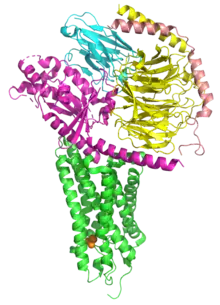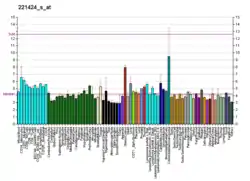OR51E2
Olfactory receptor 51E2 is a protein that in humans is encoded by the OR51E2 gene.[5][6]
Olfactory receptors interact with odorant molecules in the nose, to initiate a neuronal response that triggers the perception of a smell. The olfactory receptor proteins are members of a large family of G-protein-coupled receptors (GPCR) arising from single coding-exon genes. Olfactory receptors share a 7-transmembrane domain structure with many neurotransmitter and hormone receptors and are responsible for the recognition and G protein-mediated transduction of odorant signals. The olfactory receptor gene family is the largest in the genome. The nomenclature assigned to the olfactory receptor genes and proteins for this organism is independent of other organisms.[6]
Structure

Its structure was determined in 2023, the first elucidation of the structure of a human olfactory receptor.[7][8][9]
Ligands
OR51E2 is a relatively narrowly tuned olfactory receptor, meaning it responds only to a relatively small set of related odorants.[10]
OR51E2 responds to short-chain fatty acids,[11] including in particular propionic acid.[10]
See also
References
- GRCh38: Ensembl release 89: ENSG00000167332 - Ensembl, May 2017
- GRCm38: Ensembl release 89: ENSMUSG00000043366 - Ensembl, May 2017
- "Human PubMed Reference:". National Center for Biotechnology Information, U.S. National Library of Medicine.
- "Mouse PubMed Reference:". National Center for Biotechnology Information, U.S. National Library of Medicine.
- Xu LL, Stackhouse BG, Florence K, Zhang W, Shanmugam N, Sesterhenn IA, et al. (December 2000). "PSGR, a novel prostate-specific gene with homology to a G protein-coupled receptor, is overexpressed in prostate cancer". Cancer Research. 60 (23): 6568–6572. PMID 11118034.
- "Entrez Gene: OR51E2 olfactory receptor, family 51, subfamily E, member 2".
- PDB: 8F76; Billesbølle CB, de March CA, van der Velden WJ, Ma N, Tewari J, Del Torrent CL, et al. (March 2023). "Structural basis of odorant recognition by a human odorant receptor". Nature. 615 (7953): 742–749. Bibcode:2023Natur.615..742B. doi:10.1038/s41586-023-05798-y. PMID 36922591. S2CID 254975795.
- Kim SE (2023). "Scientists sniff out the structure of a human olfactory receptor". Chemical & Engineering News. 101 (10): 6. doi:10.1021/cen-10110-scicon3.
- Parry W (1 May 2023). "How a Human Smell Receptor Works Is Finally Revealed". Quanta Magazine.
- Saito H, Chi Q, Zhuang H, Matsunami H, Mainland JD (March 2009). "Odor coding by a Mammalian receptor repertoire". Science Signaling. 2 (60): ra9. doi:10.1126/scisignal.2000016. PMC 2774247. PMID 19261596.
- Pluznick JL, Protzko RJ, Gevorgyan H, Peterlin Z, Sipos A, Han J, et al. (March 2013). "Olfactory receptor responding to gut microbiota-derived signals plays a role in renin secretion and blood pressure regulation". Proceedings of the National Academy of Sciences of the United States of America. 110 (11): 4410–4415. Bibcode:2013PNAS..110.4410P. doi:10.1073/pnas.1215927110. PMC 3600440. PMID 23401498.
Further reading
- Adams MD, Kerlavage AR, Fleischmann RD, Fuldner RA, Bult CJ, Lee NH, et al. (September 1995). "Initial assessment of human gene diversity and expression patterns based upon 83 million nucleotides of cDNA sequence" (PDF). Nature. 377 (6547 Suppl): 3–174. PMID 7566098.
- Xia C, Ma W, Wang F, Liu M (September 2001). "Identification of a prostate-specific G-protein coupled receptor in prostate cancer". Oncogene. 20 (41): 5903–5907. doi:10.1038/sj.onc.1204803. PMID 11593396.
- Yuan TT, Toy P, McClary JA, Lin RJ, Miyamoto NG, Kretschmer PJ (October 2001). "Cloning and genetic characterization of an evolutionarily conserved human olfactory receptor that is differentially expressed across species". Gene. 278 (1–2): 41–51. doi:10.1016/S0378-1119(01)00709-0. PMID 11707321.
- Malnic B, Godfrey PA, Buck LB (February 2004). "The human olfactory receptor gene family". Proceedings of the National Academy of Sciences of the United States of America. 101 (8): 2584–2589. Bibcode:2004PNAS..101.2584M. doi:10.1073/pnas.0307882100. PMC 356993. PMID 14983052.
- Weng J, Wang J, Cai Y, Stafford LJ, Mitchell D, Ittmann M, Liu M (February 2005). "Increased expression of prostate-specific G-protein-coupled receptor in human prostate intraepithelial neoplasia and prostate cancers". International Journal of Cancer. 113 (5): 811–818. doi:10.1002/ijc.20635. PMID 15499628. S2CID 27473061.
- Weng J, Ma W, Mitchell D, Zhang J, Liu M (December 2005). "Regulation of human prostate-specific G-protein coupled receptor, PSGR, by two distinct promoters and growth factors". Journal of Cellular Biochemistry. 96 (5): 1034–1048. doi:10.1002/jcb.20600. PMID 16149059. S2CID 20908653.
- Xu LL, Sun C, Petrovics G, Makarem M, Furusato B, Zhang W, et al. (2006). "Quantitative expression profile of PSGR in prostate cancer". Prostate Cancer and Prostatic Diseases. 9 (1): 56–61. doi:10.1038/sj.pcan.4500836. PMID 16231015.
- Wang J, Weng J, Cai Y, Penland R, Liu M, Ittmann M (June 2006). "The prostate-specific G-protein coupled receptors PSGR and PSGR2 are prostate cancer biomarkers that are complementary to alpha-methylacyl-CoA racemase". The Prostate. 66 (8): 847–857. doi:10.1002/pros.20389. PMID 16491480. S2CID 25548828.
External links
- OR51E2+protein,+human at the U.S. National Library of Medicine Medical Subject Headings (MeSH)
This article incorporates text from the United States National Library of Medicine, which is in the public domain.




